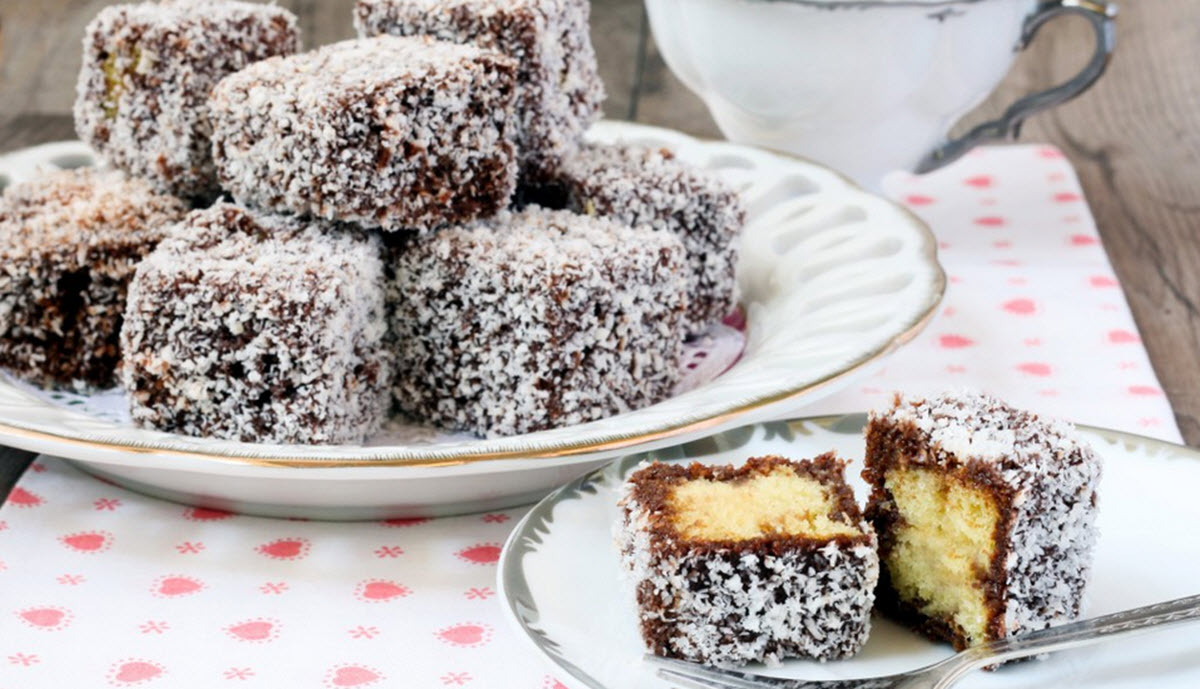Lamington
The lamington (also known simply as “Lammo”) is an Australian delicacy made from squares of butter cake or sponge cake, coated in an outer layer of chocolate sauce and rolled in desiccated coconut. Some recipes include raspberry sauce.
Lamingtons aren’t eaten right away; they are left to set, allowing the coating to seep into the cake.
If you are feeling particularly decadent, try a double lamington, where a layer of cream and/or strawberry jam joins two lamington halves together.

Lamington Day
July 21 is National Lamington Day in Australia.
Make your own Lamington
Ingredients for the sponge cake
- 3 eggs
- ½ cup powdered sugar
- ½ cup of milk
- 1 teaspoon of vanilla essence
- 1 cup of self-rising flour
- ½ cup butter
Ingredients for the coating
- 4 cups powdered sugar
- 1/3 cup cocoa powder
- ½ cup milk
- 2 tablespoons butter
- 4 tablespoons boiling water
- 3 cups shredded coconut
Instructions
- Start by making the sponge cake. This should ideally be done well in advance before you expect to serve the lamingtons, because the sponge cake should be left to settle for at least 24 hours before you put the coating on, and then the finished lamingtons should be left alone for at least a couple of hours to allow the chocolate to soak in before you serve them.
- Preheat the oven to 180 degrees C or 355 degrees F. To make the batter for the sponge cake, beat the eggs well in a bowl and then gradually whisk in sugar until you have an even batter. Stir in milk, vanilla essence and flour. Finally, whip the butter into the mixture.
- Pour the sponge cake batter into a square or rectangular cake tin (or special Lamington baking dish) and bake in the preheated oven for 30-40 minutes.
- Take out the cake and allow it to cool in room temperature for at least 15 minutes, before putting it in the fridge to rest for another 24 hours.
- When the cake has finished resting, make the chocolate sauce. Pour icing sugar and cocoa powder into a big bowl and stir it vigorously. Stir in milk, butter and boiling water.
- Pour the chocolate sauce into a saucepan and gently warm it over very low heat until the texture is smooth and creamy. (If you have a bain-marie, it will be perfect for this job.)
- Cut the sponge cake into squares.
- Pour desiccated coconut out on a tray.
- Dip a sponge cake square into the chocolate sauce and make sure it gets well covered on all sides. Then dip it into the coconut. Put the finished lamington on parchment paper to cool down.
- Repeat until all sponge cake squares have been coated in chocolate and coconut.
- Leave the lamingtons to rest for at least a couple of hours before eating them.
History of the Lamington
Exactly when the lamington was invented and how it got its name is still up for debate, but most sources link it to the Lamington family in Queensland. In 1896 – 1901, Lord Lamington served as Governor of Queensland and the lamington may have been named after him or after his wife, Lady Lamington. The earliest known reference to the naming of the lamington, which is from June 1927, claims that Lord Lamington is the source of the name.
So, who invented the lamington? Once again, most sources point to the Lamington household in Queensland, Australia. The Lamington family employed a chef, the French-born Armand Galland. According to one often repeated story, guests showed up unexpectedly and Galland had to improvise to feed them something with the ingredients ha had available. Noticing that there was some French vanilla sponge cake left over from the day before, he promptly cut it into slices, dipped the slices in chocolate sauce and adorned them with coconut. The guests were so impressed by the creation that they asked for the recipe – and the practise of serving “lamingtons” began to spread.
The first known mentioning of the lamington is from 1896, when a newspaper published a story about a “Lamington Function” held in Laidley, Queensland. The event was held in honour of Lord Lamington, and the dishes were therefore called “Lamington Soup”, “Lamington Tea”, etc.
In 1900, a recipe for Lamington Cakes was published in the newspaper “Queensland Country Life”. It gradually spread to other newspapers, including one in the capital and one in New Zealand.
